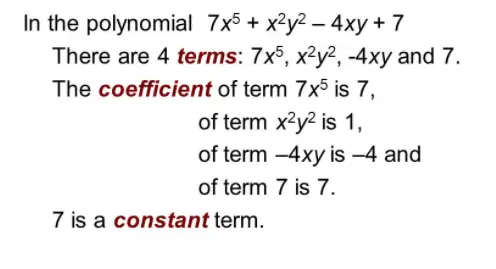The constant term of a polynomial refers to the term in the polynomial in which the variable/letter does not appear. For example, given the polynomial “3x + 4” the constant term is 4 since “x” does not appear alongside 4.

Examples:
- The polynomial y2 + 8y +1 has a constant term equal to 1.
- The polynomial a4 + 6a2 +2a -7 has a constant term equal to -7. Notice that the constant term (free from the variable “a”) is a negative number
- The polynomial 3x/5 + 7/9 has a constant term equal to 7/9.
How to find the constant term of a polynomial?
In order to find the constant term of a polynomial, we should simply look at the term where the variable/letter is absent.
For instance, in the polynomial x3-4x2+8x+9, we see that 9 is free of the letter “x”. So for this polynomial, the constant term is equal to +9.
Given a polynomial p(x) another way to find the constant term is to simply put x=0, that is finding p(0).
So if p(x) = x3-4x2+8x+9 then p(0) = 03-4*02+8*0+9 = 9. Hence we conclude that the constant term of the polynomial is 9.
If a polynomial is given in the standard form (in descending order of degree) then the term occurring at the last is the constant term.
Constant term in quadratic equation
A quadratic polynomial is of the form ax2+bx+c. Here the highest power of “x” is 2. The constant term, in this case, is “c”. Note that it can be both either positive or negative.
- The quadratic polynomial 3x2+4x+2 has a constant term equal to 2.
- The quadratic polynomial x2+7x-3 has a constant term equal to -3. Notice that here the constant term is negative.